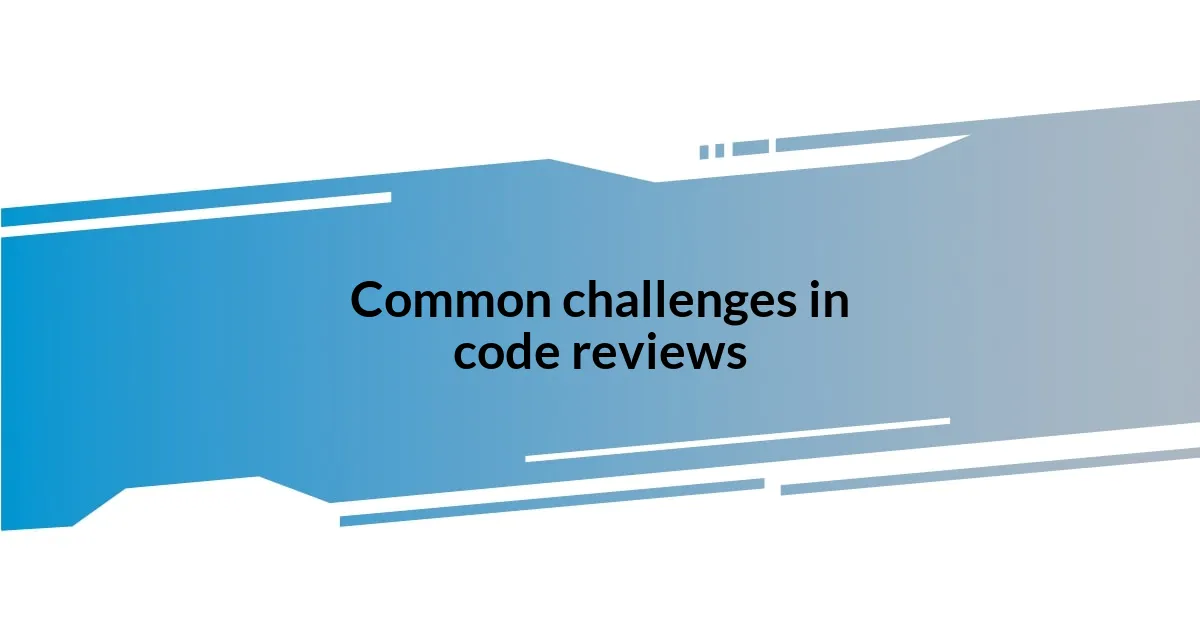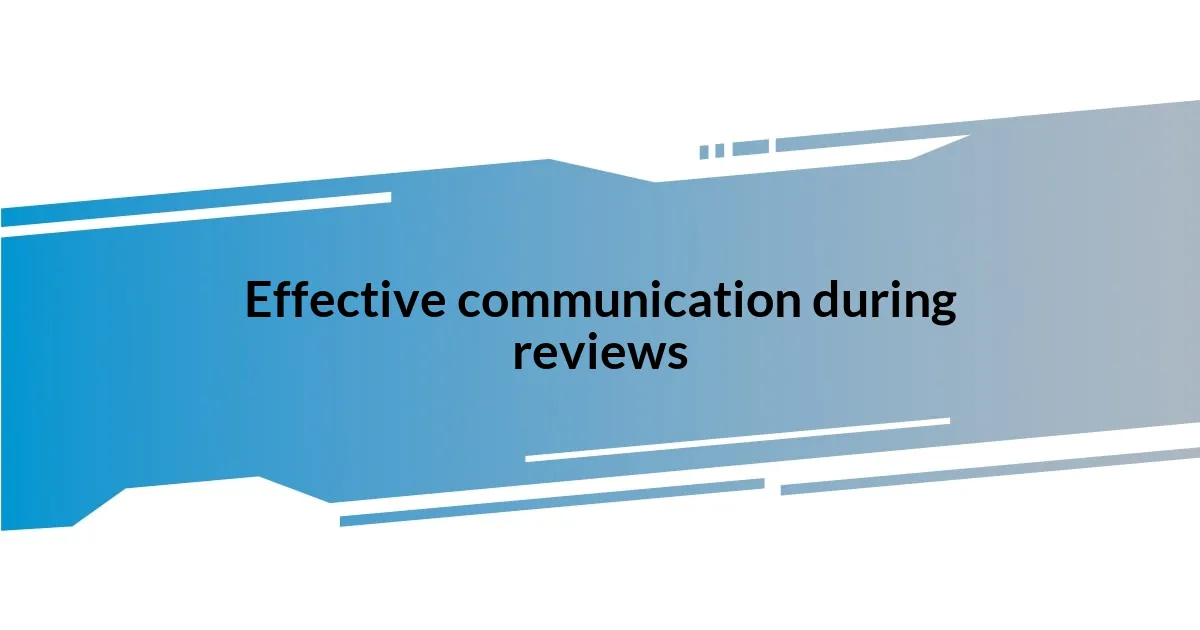Key takeaways:
- Clear communication and a respectful culture are essential for effective code reviews, helping to bridge misunderstandings and reduce emotional responses to criticism.
- Using techniques like the “sandwich method” for feedback and framing observations as questions fosters productive dialogue and collaboration.
- Incorporating feedback is a mindset shift that encourages continuous learning and improvement, enhancing both individual skills and team dynamics.
- Sharing knowledge during code reviews can catalyze growth for both individuals and the team, transforming the process into a collaborative experience.

Common challenges in code reviews
One of the biggest challenges in code reviews is communication breakdown. I remember a time when I had spent hours dissecting a colleague’s code, only to realize later that I misunderstood their approach entirely. Have you ever been in a similar situation? Clear communication is essential, and it’s crucial to clarify intentions and expectations.
Another hurdle is the emotional aspect – nobody likes criticism, myself included. I can recall a moment when I received feedback on a project that I was particularly proud of, and it stung. It made me think: how can we approach critiques in a way that feels constructive rather than discouraging? A culture of respect goes a long way in addressing this.
Sometimes, the sheer volume of code to review can be overwhelming. I’ve faced instances where I felt pressured to rush through reviews to meet deadlines. How do we strike a balance between thoroughness and efficiency? I’ve learned that focusing on smaller, manageable sections can help alleviate this pressure while still ensuring quality.

Effective communication during reviews
Effective communication during code reviews is something I’ve come to value immensely. I remember a review session where my feedback on a code structure was initially met with confusion. Instead of just pointing out the issue, I learned to explain my reasoning and the potential impact on the overall project. This not only clarified the matter but also fostered a dialogue that led to a better understanding on both sides.
It’s also important to remember how tone can influence the recipient’s perception of feedback. In one instance, I received a comment that felt more like a personal attack than constructive criticism. It was a tough pill to swallow, but it taught me to always choose my words thoughtfully. When giving feedback, I strive to be supportive and highlight positive aspects alongside any necessary criticism. This balance creates an atmosphere where team members can grow rather than feel defeated.
Additionally, I find asking for input from the person being reviewed can enhance communication significantly. During a code review, instead of only delivering my feedback, I started to ask questions like, “What do you think about this approach?” or “How do you feel this part of the code could be improved?” This not only engages the other person but also encourages them to take ownership of their work. Communication is truly a two-way street, and these moments can lead to richer discussions that elevate the entire team.
| Effective Communication Aspect | My Insights |
|---|---|
| Clarifying Intentions | Explaining reasoning behind feedback fosters understanding. |
| Tone of Feedback | Choosing supportive language helps maintain morale and collaboration. |
| Engaging Others | Asking for input turns feedback into a constructive dialogue. |

Best practices for giving feedback
When providing feedback, I’ve learned that framing my observations as questions can lead to more productive conversations. For instance, during a review, I might say, “Have you considered how refactoring this part might enhance readability?” This approach encourages collaboration and invites the author to reflect rather than feel defensive. Being curious rather than critical helps transform the feedback experience into a shared journey of improvement.
One effective strategy I adopt is the “sandwich method,” where I start with something positive, followed by constructive criticism, and then end on an encouraging note. I remember a time I had to give tough feedback on a feature implementation. I began by acknowledging the effort put into it, discussed the specific changes needed, and concluded by highlighting the project’s potential impact. This balanced approach not only made the person feel valued but also kept the lines of communication open. Here’s a quick bullet list of best practices I keep in mind:
- Ask Questions: Frame feedback as inquiries to foster reflection and discussion.
- Use the Sandwich Method: Start with positives, address concerns, and conclude with encouragement.
- Be Specific: Highlight exact areas for improvement rather than vague comments.
- Stay Objective: Focus on the code, not the coder, to avoid personalizing feedback.
- Follow Up: Offer to discuss feedback further and provide support as needed.

Incorporating feedback into development
I’ve found that genuinely incorporating feedback into development isn’t just about technical changes; it’s also a mindset shift. I remember a project where my initial reaction to feedback was defensive, thinking, “Why should I change something that works?” But then, I realized every piece of feedback was an opportunity to elevate my code and my skills. It took conscious effort to embrace this perspective, but it transformed my development process into a cycle of continuous learning.
I also learned the importance of integrating feedback into my workflow. After a code review, I started setting aside time to revisit suggested changes and not just implement them blindly—this helped me to fully understand the reasoning behind them. For example, after one review pointed out inconsistent variable naming, I took a weekend to not only fix those instances but also reflect on how this could improve overall readability. Now, I ask myself, “How can I apply this learning to future projects?” Keeping a learning attitude not only leads to smarter code but also builds credibility within my team.
Furthermore, I believe that maintaining an open dialogue after incorporating feedback strengthens trust among team members. When I adjusted code based on reviews, I often shared my thought process in follow-up sessions. This practice reinforced accountability and helped address any lingering concerns others might have had. It’s amazing how discussing the ‘why’ behind my choices can change perceptions; I’ve seen colleagues start to come to me for advice instead of waiting for reviews. Isn’t it satisfying when feedback becomes a two-way street, fueling a culture of growth where everyone feels empowered to contribute?

Continuous improvement through code reviews
Striving for continuous improvement through code reviews has opened my eyes to the profound impact feedback can have on my coding journey. For instance, during one review, a colleague suggested experimenting with a new library that seemed intimidating at first. However, embracing that challenge led me not only to write cleaner code but also to understand a different aspect of our tech stack. I can still recall the thrill I felt when everything clicked into place after that switch—it reminded me that flexibility is key in our field.
What I’ve come to realize is that code reviews are less about finding faults and more about fostering better coding practices. I remember a time when I hesitated to share certain coding techniques with my team, thinking they might not be well-received. When I finally did, the enthusiastic response not only validated my concerns but also sparked a collaborative brainstorming session that enlivened our approach to coding. Isn’t it fascinating how sharing knowledge can catalyze growth for both the individual and the team?
It’s also crucial to recognize that the process of seeking and applying feedback serves as a continuous loop of growth. One of my personal goals is to leave a code review feeling more knowledgeable than when I started. After receiving constructive feedback on my use of comments, I began experimenting with ways to clarify my logic rather than rely solely on inline explanations. The transformation was staggering; suddenly, my methods were not only clearer for my teammates but also for future me! Wouldn’t you agree that enhancing our coding practices through collaborative reflection is one of the most rewarding parts of being a developer?